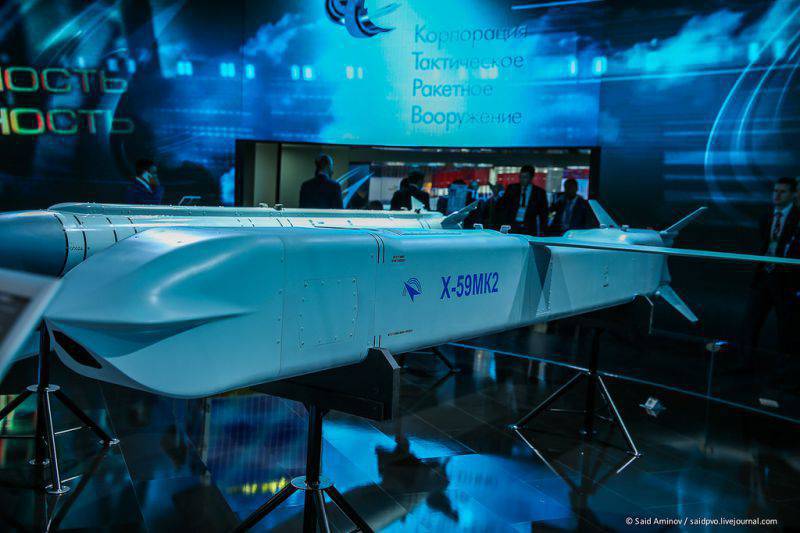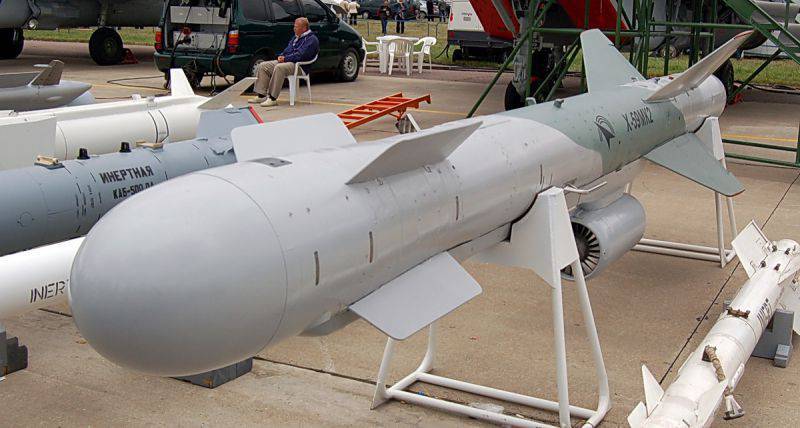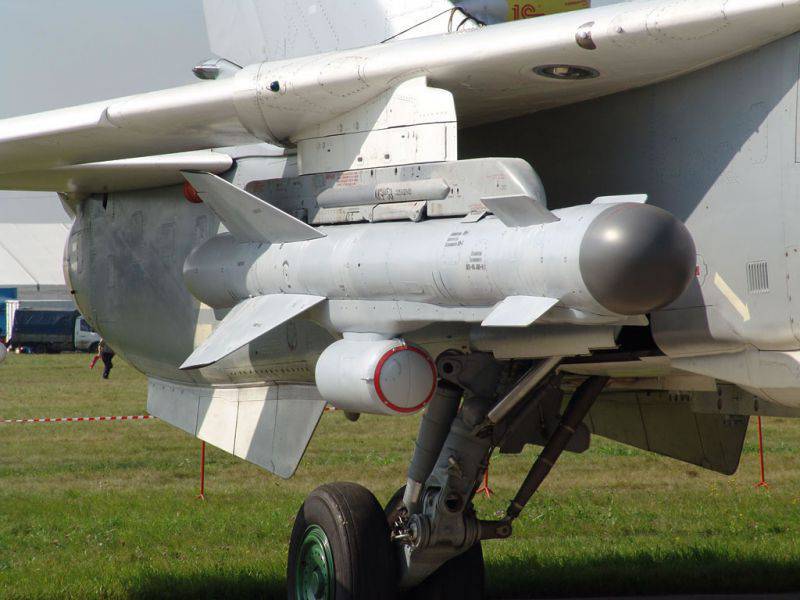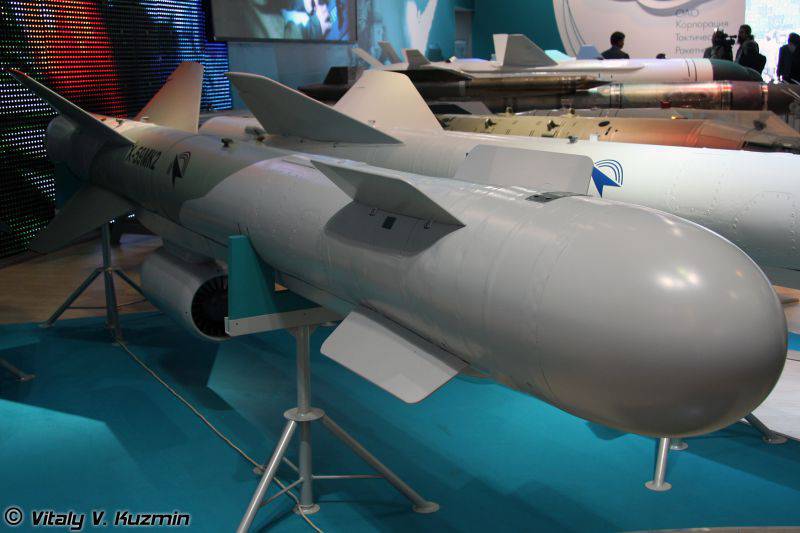Air-to-surface missile X-59MK2
Over the past few decades, the GosMCB Raduga, which is now part of the Tactical Missile Weapons Corporation (KTRV), has been developing the X-59 family of rockets. It was this organization that at one time developed the base project X-59, and then presented the updated X-59M rocket, the development of which are modern designs. The penultimate representative of the family at the moment, the product X-59МК2, was first presented at the MAKS-2009 exhibition.
As before, the next project of the family implied the use of a mass of ready-made ideas, as well as some new equipment. Due to this, it was supposed to maintain a fairly high degree of unification, as well as to increase the performance and give the rocket new combat capabilities. As a result of this, the X-59МК and Х-59МК2 missiles have a similar construction and layout, and all the existing differences are related only to the composition of the equipment used.
Product X-59MK2 retains the tailless aerodynamic layout used in all previous projects. The main element of the rocket is a cylindrical body of large elongation with an expanding conical head and fairing. A protruding straight leg is provided on the lower surface of the hull, under which there is a pylon with a cylindrical casing of the main engine. In addition, X-shaped destabilizers and wings are located on the lateral surface of the hull.
The composition and design of the planes without changes were borrowed from the previous project. On the conical head part of the hull there are four destabilizers of small elongation with an arrow-shaped leading edge, designed to improve controllability in flight. In the tail part of the rocket, swept wings are placed with rudders on the rear edge.
In their dimensions, two missiles with the letters "MK" do not differ from each other. Their total length is 5,7 m, the diameter of the cylindrical part of the body is 380 mm, the maximum diameter of the head fairing is 420 mm. The wing has a span of 1,3 m. Item X-59MK2 is slightly lighter than its predecessor. Its starting mass, according to the developer, does not exceed 900 kg and depends on the type of warhead.
The layout of the X-59M family of rockets is similar. The project X-59MK2 does not use any new original solutions. So, in the head part of the body there is a homing head and part of the control automation. Behind her set the warhead with a fuse and fuel tank. The tail section of the hull accommodates a second instrument compartment with steering machines and an additional fuel tank, which makes it possible to significantly increase the flight range.
The X-59MK missile was designed to hit surface targets of the type “boat” or “ship”, which affected the composition of its equipment and imposed certain restrictions on combat use. In the project "MK2" it was decided to use the developments on the existing anti-ship missile, but at the same time significantly expand the range of tasks of the new weapon. As a result, the X-59MK2 guided missile can be used to destroy various stationary ground targets with known coordinates. Declared the possibility of attacking a target that has no optical, radar or infrared contrast with the surrounding terrain. Also, missile control systems operate on the principle of "launched-forgotten."
Product X-59MK2 received a combined guidance system based on several blocks. It includes a strapdown inertial navigation system, satellite navigation equipment, a correlation-optical homing head and an autopilot. To perform low-altitude flight there is a radio altimeter A-079E. In preparation for launching, a flight mission is introduced into the memory of the missile control systems with a flight route, including at low altitudes. In order to break through the enemy's air defense, the missile is able to fly at altitudes 50-300 m.
For aiming at a target with known coordinates, the X-59MK2 rocket uses a relatively complex method of control system joint operation. In the area of the target rocket out using inertial navigation with correction signals from navigation satellites. After that, the target is detected with the help of an optical seeker that performs the final guidance of the missile at the desired object. The homing head can work at any time of the year when the terrain is illuminated to at least 103-105 lux. According to official data, missile control systems provide circular probable deviations at the 3-5 m level.
The rocket of the new model, unlike the base X-59MK, can carry two types of combat units. Depending on the type of target, it is possible to use a missile with a penetrating high-explosive or cluster warhead. Penetrating warhead weighs 320 kg, cassette - 283 kg. The latter is equipped with cumulative fragmentation submunitions designed to destroy objects in a certain area.
A double-flow turbojet TRDD-50AT (36МТ) is suspended under a rocket body on a special pylon. With a body weight of 82 kg, a length of 850 mm and a diameter of 330 mm, this product provides traction up to 450 kgf. The engine, developed by the Omsk Engine-Building Design Bureau and produced by NPO Saturn, is capable of operating at different altitudes and delivering the necessary traction depending on the rocket flight mode. For efficient operation and proper fuel consumption, the engine is equipped with an electronic-hydraulic control system.
Using the TRDD-50AT engine, the X-59MK2 guided missile can reach speeds from 900 to 1050 km / h and fly at altitudes from 200 m to 11 km. It should be noted that in most cases the rocket must fly at a minimum height, due to which it can pass unnoticed through the zone of the air defense of the enemy.
The combined control system used makes it possible with equal effectiveness to attack targets at different ranges, up to the maximum. The minimum launch range of the X-59МК2 rocket ranges from 5 to 25 km, depending on the flight parameters of the aircraft carrier at the time of the reset. The maximum firing range is 285 km.
The discharge of the X-59МК2 rocket from a carrier aircraft is allowed at altitudes from 200 m to 11 km. In this case, the aircraft can move at a speed of at least 600 and no more than 1100 km / h. You should also consider the direction to the attacked object. Perspective at launch - no more than 45 ° from the rocket axis.

"Upgrade Option aviation Kh-59MK2 guided missile "at the MAKS-2015 exhibition. Photo by Saidpvo.livejournal.com
The carriers of X-59MK2 guided missiles can be various modern domestic fighters and front-line bombers. For transportation and use of this weapon, according to some data, the aircraft must be equipped with an AKU-58-1 aircraft ejection device and have the corresponding functions of aim-navigation equipment. The number of missiles transported, ready for use, depends on the type of carrier and the assigned combat mission.
The layout of the promising X-59MK2 air-to-surface missile was first shown at the MAKS-2009 exhibition. In the future, KTRV repeatedly presented materials on these weapons at various exhibitions and showrooms. In August, 2015, the "premiere" of the new X-59M family of rockets took place, which is a further development of the X-59MK2 product.
The rocket shown this year has not yet received its own name and is still referred to as the “Variant of modernization of the X-59MK2 aviation guided missile”. The appearance of the new product clearly indicates a profound modernization with the most serious processing of the original project. With a similar composition of equipment and about the same characteristics, the upgraded version differs from the basic X-59МК2 body design and aerodynamic appearance. The new rocket received a body of a characteristic form indicating the use of the so-called. stealth technology.
The development of the X-59 guided missile began in the early seventies. By the early nineties, an upgraded X-59M appeared. A few decades after the start of work on the very first project, the organization-developer continues to develop a family of guided weapons, the modernization potential of which, apparently, has not yet been exhausted. It is quite possible that at future exhibitions of armaments and military equipment of the GosMKB Raduga and KTRV will again present the next options for upgrading the X-59M family of missiles.
On the materials of the sites:
http://ktrv.ru/
http://rbase.new-factoria.ru/
http://airwar.ru/
http://vpk.name/



Information